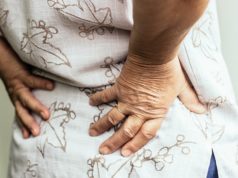
An evidence-based clinical practice guideline from the American College of Physicians published in Annals of Internal Medicine has recommended that physicians and patients should treat acute or subacute low back pain with alternative therapies such as superficial heat, massage, acupuncture, or spinal manipulation. If drug therapy is desired, physicians and patients should select nonsteroidal anti-inflammatory drugs (NSAIDs) or skeletal muscle relaxants.
“Physicians should reassure their patients that acute and subacute low back pain usually improves over time regardless of treatment,” says Nitin S Damle, president of the American College of Physicians. “Physicians should avoid prescribing unnecessary tests and costly and potentially harmful drugs, especially narcotics, for these patients.”
The evidence showed that acetaminophen was not effective at improving pain outcomes versus placebo. Low-quality evidence showed that systemic steroids were not effective in treating acute or subacute low back pain.
For patients with chronic low back pain, the American College of Physicians recommends that physicians and patients initially select non-drug therapy with exercise, multidisciplinary rehabilitation, acupuncture, mindfulness-based stress reduction, tai chi, yoga, motor control exercise (MCE), progressive relaxation, electromyography biofeedback, low level laser therapy, operant therapy, cognitive behavioural therapy, or spinal manipulation.
The College’s recommendation of acupuncture is in conflict with the latest advice from the UK’s National Institute for Health and Care Excellence, which concludes that there is not enough evidence to recommend this treatment for low back pain. Similarly, the latest Cochrane Review does not recommend superficial heat therapy for low back pain, citing a limited base of evidence.
“For the treatment of chronic low back pain, physicians should select therapies that have the fewest harms and costs, since there were no clear comparative advantages for most treatments compared to one another,” Damle says. “Physicians should remind their patients that any of the recommended physical therapies should be administered by providers with appropriate training.”
For patients with chronic low back pain who have had an inadequate response to non-drug therapy, ACP recommends that physicians and patients consider treatment with NSAIDs as first line therapy; or tramadol or duloxetine as second line therapy. Physicians should only consider opioids as an option in patients who have failed the aforementioned treatments, the recommendations say, and only if the potential benefits outweigh the risks for individual patients. Prescription of opioids should only take place after a discussion of known risks and realistic benefits with patients, the advice says.
“Physicians should consider opioids as a last option for treatment and only in patients who have failed other therapies, as they are associated with substantial harms, including the risk of addiction or accidental overdose,” says Damle.
The recommendations are based on a systematic review of randomised controlled trials and systematic reviews published on noninvasive pharmacological and non-pharmacological treatments of nonradicular low back pain. Clinical outcomes evaluated included reduction or elimination of low back pain, improvement in back-specific and overall function, improvement in health-related quality of life, reduction in work disability/return to work, global improvement, number of back pain episodes or time between episodes, patient satisfaction, and adverse effects.
The evidence was insufficient or lacking to determine treatments for radicular low back pain. The evidence also was insufficient for most physical modalities and for which patients are likely to benefit from which specific therapy. The guideline does not address topical therapies or epidural injection therapies.













